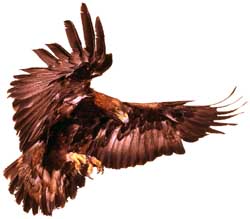DK Nature: Birds
Birds have wings covered with feathers, which allow most of them to fly. Most birds also have extremely good eyesight and hearing. They reproduce by laying eggs, and many build NESTS to rear their young. Some birds fly on long journeys called MIGRATIONS to breed or find food.
Birds have evolved many features to make flight possible. The skeleton is strong but light, with a large breastbone to support powerful muscles for flapping wings up and down. The wings themselves are curved on top, flatter beneath—air travels faster over the upper surface, producing lift. The long tail helps with direction and balance; strong legs assist with takeoff.
Feathers on a bird’s wings provide a lightweight but solid surface to push against the air. As the wing flaps downward, the feathers mesh together, then part to allow air through as it sweeps upward again. As well as allowing it to fly, a bird’s feathers keep it warm and dry.
Some island birds, such as New Zealand’s kiwis, lost the ability to fly because their islands had few predators. Large flightless birds such as ostriches, emus, and rheas are strong runners. Penguins cannot fly, but are expert at swimming and diving.
Birds eat a wide range of plant and animal foods. Some feed on specific parts of plants, such as fruit, seeds, or nectar. Others are predators. Hawks, owls, and eagles catch smaller creatures such as rodents. Many sea birds feed on fish. Some shore birds have long beaks to probe the mud for worms.
Birds’ feet are shaped to help them move in their particular habitat. The jacana’s long toes allow it to walk on floating water plants without sinking. Ostriches’ hooflike toes help with running, and ducks’ webbed feet with swimming. Eagles’ talons are designed to seize prey, while the feet of perching birds, such as pipits, lock around twigs.
| With around 9,000 species, birds make up the second-largest vertebrate class after fish. They are also the most widespread, occurring from the polar ice caps to the most isolated islands. |
| Birds are classified into 27 different orders. |
| The largest order, Passeriformes or perching birds, includes over half of all bird species. |
| The smallest order has just one species—the ostrich. |
Nests are safe places where birds lay their eggs and rear their young. Adult birds do not normally sleep in nests, but roost in trees or other sheltered spots. Different bird species build different types of nest. Some are simple, others extremely complex.
Many birds nest in trees because eggs laid there will be out of reach of many predators. Some birds nest in other inaccessible places. For example, swallows and martins nest under the eaves of houses, and storks on rooftops. Many sea birds, such as gulls, nest on cliff ledges, while kingfishers dig burrows in riverbanks.
The young of ground-nesting birds, such as ducks and geese, hatch out as fluffy chicks that are soon able to stand and fend for themselves. Most birds, however, hatch out blind, bald, and helpless. Their parents bring them food for several weeks while their feathers sprout and they grow strong enough to leave the nest.
Many birds fly long distances on yearly migrations to find food, avoid drought or winter chill, or reach sheltered spots to rear their young. In spring, many fly to cooler regions where food is abundant in summer. They return to warmer lands for winter.
Changing temperatures and daylight are thought to trigger bird migrations. In some species, the young follow their parents and learn the way from them. Others set off alone, guided by instinct. Birds navigate using the position of the Sun, Moon, stars, and physical landmarks. Some can sense Earth’s magnetic field.
Many kinds of animals migrate, from mammals, reptiles, and amphibians to crustaceans, fish, and insects. Reindeer move across the Arctic tundra, and wildebeest cross the African plains to find fresh grazing. In the oceans, blue and gray whales swim from polar seas to mate in the tropics.

